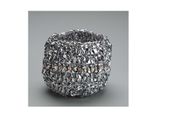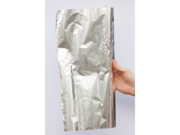Aluminum foil
Description
A thin sheet of Aluminum or an aluminum alloy. Aluminum foil is rolled to thicknesses of about 20 microns or less. It generally has one highly polished side and one matte side because two sheets are rolled at the same time then separated. Aluminum foil tears easily, is impermeable to air, reflective to radiation, and has commonly been used for packaging food. It is also laminated to Paper, Boards, and Plastic to provide a vapor barrier layer. Crumpled aluminum foil has also been used for thermal insulation.
Synonyms and Related Terms
tin foil; al-foil; alu-foil; aluminium foil (Br.); stanniol (Dan.); tinfoile (Dan.); Alufolie (Deut.); Aluminiumfolie (Deut., Ned.); feuille d'aluminium (Fr.); papel de aluminio (Esp.); zilverpapier (Ned.); folha de alumínio (Port.); Reynolds Wrap® ; Alcoa wrap
Collection Risks
Links to Oddy Test results posted on AIC Wiki Materials Database Pages for individual materials below
° Aluminium Kitchen Foil Tested in 2009
° Pure Nature Pure Aluminium Barrier Foil Tested in 2009
Physical and Chemical Properties
Thicknesses range from 6-20 microns (0.0065 - 0.020 mm)
Resources and Citations
- Jean Tétreault, Low-Cost Plastic/Aluminum Barrier Foil, CCI Notes 1/9, Canadian Conservation Institute by X. Ottawa (2010), Link
- G.S.Brady, Materials Handbook, McGraw-Hill Book Co., New York, 1971 Comment: p. 64
- Dictionary of Building Preservation, Ward Bucher, ed., John Wiley & Sons, Inc., New York City, 1996
- Wikipedia: http://en.wikipedia.org/wiki/Aluminum_foil (Accessed Mar. 15, 2006) -for non-English terms

